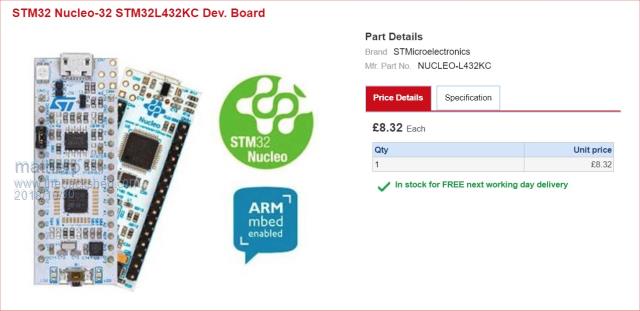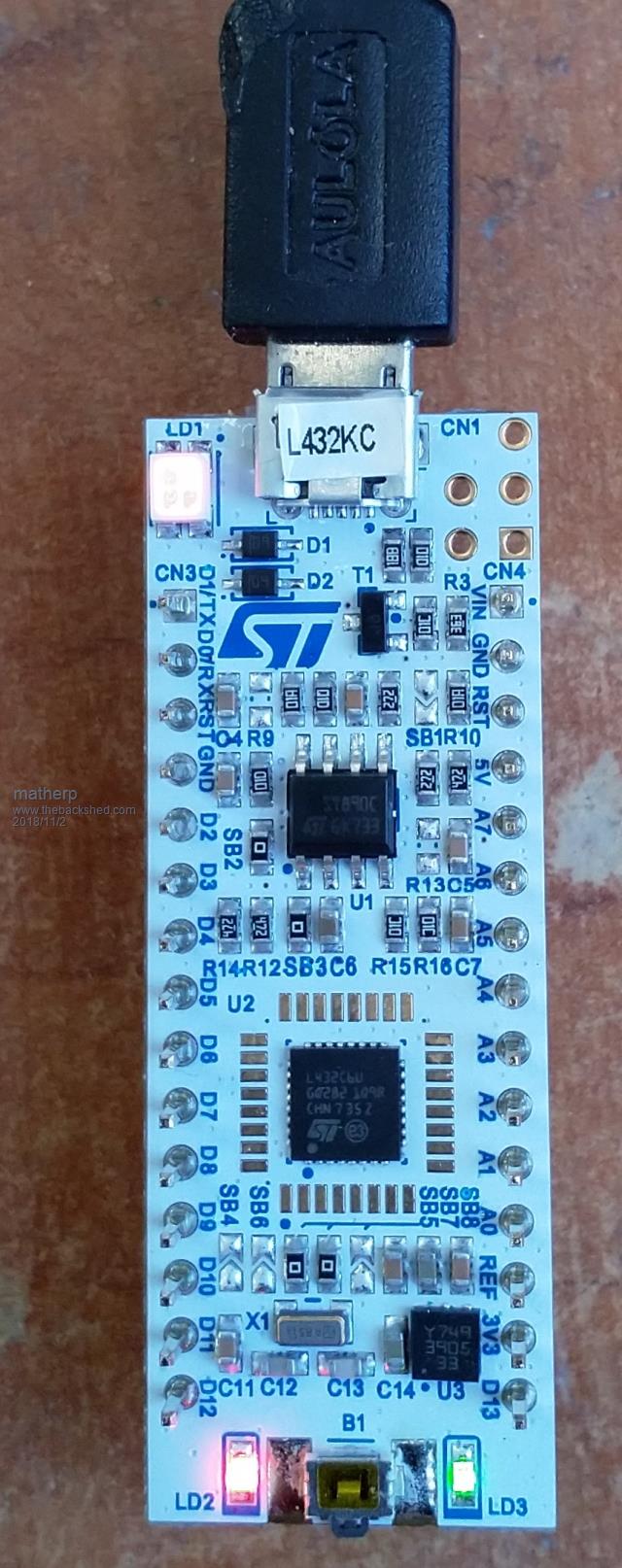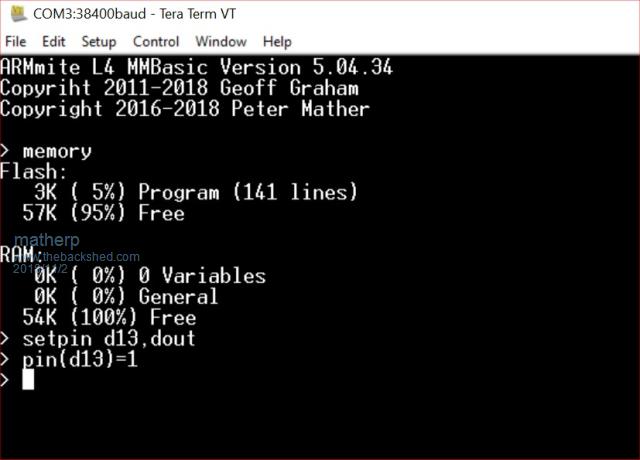
|

|
Forum Index : Microcontroller and PC projects : Thinking about a very low power Micromite
| Page 1 of 3 |
|||||
| Author | Message | ||||
| matherp Guru Joined: 11/12/2012 Location: United KingdomPosts: 10687 |
I've got an application which needs to be battery powered and unattended over long durations. The experts in ultra low power processing are STM so I'm considering a new port of MMBasic to one of their STM32L4 devices. Unfortunately they have no PDIP devices in their portfolio but they do have 32, 48, and 64 pin LQFP on 0.5mm pitch which are easy enough to solder. For a basic MM2 equivalent with some MM+ capability the 48-pin STM32L431CC (details below) seems an interesting proposition. Note the power consumption of 280nA in standby mode with RTC. This mode could be used to wake the micromite at pre-programmed times to do something and then wait, consuming almost no power until the next processing cycle. Is this something that would be of general interest? The port shouldn't be too difficult given the work on the STM32H7. The "new" functionality would be around making use of the low power modes. Ultra-low-power with FlexPowerControl 1.71 V to 3.6 V power supply -40 °C to 85/105/125 °C temperature range 200 nA in VBAT mode: supply for RTC and 32x32-bit backup registers 8 nA Shutdown mode (5 wakeup pins) 28 nA Standby mode (5 wakeup pins) 280 nA Standby mode with RTC 1.0 μA Stop 2 mode, 1.28 μA with RTC 84 μA/MHz run mode Batch acquisition mode (BAM) 4 μs wakeup from Stop mode Brown out reset (BOR) Interconnect matrix Core: Arm® 32-bit Cortex®-M4 CPU with FPU, Adaptive real-time accelerator (ART Accelerator™) allowing 0-wait-state execution from Flash memory, frequency up to 80 MHz, MPU, 100DMIPS and DSP instructions Performance benchmark 1.25 DMIPS/MHz (Drystone 2.1) 273.55 CoreMark® (3.42 CoreMark/MHz @ 80 MHz) Energy benchmark 176.7 ULPBench® score Clock Sources 4 to 48 MHz crystal oscillator 32 kHz crystal oscillator for RTC (LSE) Internal 16 MHz factory-trimmed RC (±1%) Internal low-power 32 kHz RC (±5%) Internal multispeed 100 kHz to 48 MHz oscillator, auto-trimmed by LSE (better than ±0.25 % accuracy) Internal 48 MHz with clock recovery 2 PLLs for system clock, audio, ADC Up to 83 fast I/Os, most 5 V-tolerant RTC with HW calendar, alarms and calibration Up to 21 capacitive sensing channels: support touchkey, linear and rotary touch sensors 11x timers: 1x 16-bit advanced motor-control, 1x 32-bit and 2x 16-bit general purpose, 2x 16-bit basic, 2x low-power 16-bit timers (available in Stop mode), 2x watchdogs, SysTick timer Memories Up to 256 KB single bank Flash, proprietary code readout protection 64 KB of SRAM including 16 KB with hardware parity check Quad SPI memory interface Rich analog peripherals (independent supply) 1x 12-bit ADC 5 Msps, up to 16-bit with hardware oversampling, 200 μA/Msps 2x 12-bit DAC output channels, low-power sample and hold 1x operational amplifier with built-in PGA 2x ultra-low-power comparators 16x communication interfaces 1x SAI (serial audio interface) 3x I2C FM+(1 Mbit/s), SMBus/PMBus 4x USARTs (ISO 7816, LIN, IrDA, modem) 1x LPUART (Stop 2 wake-up) 3x SPIs (and 1x Quad SPI) CAN (2.0B Active) and SDMMC interface SWPMI single wire protocol master I/F IRTIM (Infrared interface) 14-channel DMA controller |
||||
Grogster Admin Group Joined: 31/12/2012 Location: New ZealandPosts: 9773 |
YES. Interested. I currently use MM2 chips with sleep mode to save battery power. Any new development that would use MMBASIC and extend battery life in standby I could use. Smoke makes things work. When the smoke gets out, it stops! |
||||
| JohnS Guru Joined: 18/11/2011 Location: United KingdomPosts: 4164 |
I can see why it would be of real interest. One thing that caught my eye (besides the 280nA) was: 84 μA/MHz run mode which might also help with extended low power use. John |
||||
| Frank N. Furter Guru Joined: 28/05/2012 Location: GermanyPosts: 1012 |
Hi, I am also very interested in a Micromite with very low power. I've been planning for several years to build a wristwatch with a Micromite and an LS013B4DN04 Sharp Memory Display in a MetaWatch case. My previous plan was to switch off a "normal" Micromite completely and to supply it with power via an RTC at pre-programmed times (or keystrokes). A low power Micromite would be very usefull! Frank |
||||
| matherp Guru Joined: 11/12/2012 Location: United KingdomPosts: 10687 |
I've done some more research and I think I'll base the port on the STM32L432KCU6. This has the advantage that there is a very cheap Nucleo board available complete with onboard programmer (NUCLEO-L432KC)  It is a 32-pin chip, unfortunately only available as a UFQFPN-32, but these are still hand solderable (just) and given the availability of the Nucleo it seems a logical choice - thoughts? |
||||
| viscomjim Guru Joined: 08/01/2014 Location: United StatesPosts: 925 |
I REALLY like this idea also. The small dev board is nice too. Just out of curiosity, how difficult is it to port to different pincout STM32 chips overall once this port is complete? |
||||
| PicFan Senior Member Joined: 18/03/2014 Location: AustriaPosts: 133 |
I am also very interested in a Micromite with very low power. Wolfgang |
||||
| twofingers Guru Joined: 02/06/2014 Location: GermanyPosts: 1694 |
I am also interested. The price for the Nucleo board seems also good. But I'm worried about the sheer number of micromites. Who cares about support and documentation? This is something that Peter (and Geoff?) alone can not handle in the long run. - IMHO. The main reason for the success of the MMs lies in their excellent documentation and support. Both very time consuming I think. Michael causality ≠correlation ≠coincidence |
||||
| lizby Guru Joined: 17/05/2016 Location: United StatesPosts: 3504 |
+1 for low power STM micromite with dev module currently available at a reasonable price. I appreciate the great work of Peter and Geoff, and especially the continuing eye for expansion of Micromite capabilities. PicoMite, Armmite F4, SensorKits, MMBasic Hardware, Games, etc. on fruitoftheshed |
||||
| JohnS Guru Joined: 18/11/2011 Location: United KingdomPosts: 4164 |
Just wondering, but why that particular STM32L4 board/chip? Why not, for example, the NUCLEO-L433RC ? John |
||||
Grogster Admin Group Joined: 31/12/2012 Location: New ZealandPosts: 9773 |
What's the pin-pitch on this chip? 0.4mm? Smoke makes things work. When the smoke gets out, it stops! |
||||
| sawasdee01 Newbie Joined: 23/12/2016 Location: United KingdomPosts: 33 |
Hi, I think that it would be a wonderful addition - although, I wonder whether using the (nearly identical) STM32L47xxx series might have a much wider appeal to 'smart wear' and other very low power apps, which need plenty of code space for the fantastic MMBASIC graphical abilities. This would come in a 64 pin LQFP and have 512k Flash and 128k RAM, making it very similar to the MM+, albeit with a much lower power utilisation profile and the potential to have the various, super useful MM+ SPI, I2C, and COM ports fully available. Cheers all. Sawasdee |
||||
| matherp Guru Joined: 11/12/2012 Location: United KingdomPosts: 10687 |
By far the most popular Micromite is the 28-pin which covers most peoples' requirements. The STM32L432KCU6 (0.5mm pin pitch) is very equivalent to the MX170 (although faster and with H/W FPU). The NUCLEO-L432KC can plug into a breadboard or be mounted on veroboard and the main processor can be powered separately from the ST-LINK to minimise power usage. This allows the Nucleo to be used as a PDIP chip something you can't do with the bigger versions which are also more expensive. IMHO there is no point having things like GUI functionality in a low power device as TFT displays are incompatible with low power. I was intending to include support for displays like the NOKIA 5110, OLEDs and possibly the various e-ink versions in the firmware rather than things like the ILI9341/SSD1963 One downside of STM32 chips is that variants with different numbers of pins have the same device ID. This means that the code can't automatically configure itself for the number of pins making support for different version more difficult - separate executables. In summary, I certainly don't want to limit the usefulness of the port by going with the smaller chip but my instinct is that the advantages outweigh the disadvantages. As always I'm interested and open to feedback |
||||
| JohnS Guru Joined: 18/11/2011 Location: United KingdomPosts: 4164 |
It was mainly the number of pins I was wondering about - but just wondering, not overly worried or anything. The chip/board cost is really good either way. I suppose a downside of more pins would likely be more power, even if not much. John |
||||
| matherp Guru Joined: 11/12/2012 Location: United KingdomPosts: 10687 |
MMBasic is up and running on the NUCLEO-L432KC - this thing is so cute  - the same size as a 40-pin DIP and totally self-contained. - the same size as a 40-pin DIP and totally self-contained.The code moved from the Armmite H7 pretty easily I2C, SPI, Digital-IO etc. all up and running. The big changes as always are in the memory model and the way flash memory is arranged. I've got one issue with the console output occasionally dropping characters and haven't yet implemented any displays yet or played with the low power modes. The board labels the pins A0-A7 and D0-D13 so I have allowed this nomenclature as well as the normal pin number. Pin D13 is connected to LD3.   |
||||
| CaptainBoing Guru Joined: 07/09/2016 Location: United KingdomPosts: 2171 |
deleted |
||||
| viscomjim Guru Joined: 08/01/2014 Location: United StatesPosts: 925 |
Wow Matherp! This is very cool. Will have to order a couple of these now for sure. Digikey carries these over here for $10.99 and has plenty in stock. Thanks for the effort! |
||||
| lizby Guru Joined: 17/05/2016 Location: United StatesPosts: 3504 |
Wow. This is outstanding. Here's the Digikey link for U.S. buyers: NUCLEO-L432KC The low-power stuff is great, but this also looks like a wonderful general-purpose Micromite board--I hope to see as many features as possible implemented. Thanks, Peter (and Geoff) for this amazingly flexible piece of software fitted to ever-more powerful hardware. PicoMite, Armmite F4, SensorKits, MMBasic Hardware, Games, etc. on fruitoftheshed |
||||
sagt3k Guru Joined: 01/02/2015 Location: ItalyPosts: 313 |
Hi matherp Is it possible to have a pins resume and functionality? and to download the firmware? Thanks Antonio |
||||
| matherp Guru Joined: 11/12/2012 Location: United KingdomPosts: 10687 |
Too soon and I haven't yet asked Geoff for permission. Subject to change { NULL, 0, PUNUSED , NULL, 0,""}, // pin 0 { NULL, 0, PUNUSED , NULL, 0,""}, // pin 1 VDD { NULL, 0, PUNUSED , NULL, 0,""}, // pin 2 OSC32_IN { NULL, 0, PUNUSED , NULL, 0,""}, // pin 3 OSC32_OUT { NULL, 0, PUNUSED , NULL, 0,""}, // pin 4 NRST { NULL, 0, PUNUSED , NULL, 0,""}, // pin 5 VDD { GPIOA, GPIO_PIN_0, DIGITAL_IN | DIGITAL_OUT | ANALOG_IN , ADC1, ADC_CHANNEL_5,"A0"}, // pin 6 { GPIOA, GPIO_PIN_1, DIGITAL_IN | DIGITAL_OUT | ANALOG_IN , ADC1, ADC_CHANNEL_6,"A1"}, // pin 7 SPI-CLK { NULL, 0, PUNUSED , NULL, 0,""}, // pin 8 Console-TX { GPIOA, GPIO_PIN_3, DIGITAL_IN | DIGITAL_OUT | ANALOG_IN , ADC1, ADC_CHANNEL_8,"A2"}, // pin 9 { GPIOA, GPIO_PIN_4, DIGITAL_IN | DIGITAL_OUT | ANALOG_IN , ADC1, ADC_CHANNEL_9,"A3"}, // pin 10 DAC1 { GPIOA, GPIO_PIN_5, DIGITAL_IN | DIGITAL_OUT | ANALOG_IN , ADC1, ADC_CHANNEL_10,"A4"}, // pin 11 DAC2 { GPIOA, GPIO_PIN_6, DIGITAL_IN | DIGITAL_OUT | ANALOG_IN , ADC1, ADC_CHANNEL_11,"A5"}, // pin 12 SPI-IN { GPIOA, GPIO_PIN_7, DIGITAL_IN | DIGITAL_OUT | ANALOG_IN , ADC1, ADC_CHANNEL_12,"A6"}, // pin 13 SPI-OUT { GPIOB, GPIO_PIN_0, DIGITAL_IN | DIGITAL_OUT | ANALOG_IN , ADC1, ADC_CHANNEL_15,"D3"}, // pin 14 { GPIOB, GPIO_PIN_1, DIGITAL_IN | DIGITAL_OUT | ANALOG_IN , ADC1, ADC_CHANNEL_16,"D6"}, // pin 15 { NULL, 0, PUNUSED , NULL, 0,""}, // pin 16 VSS { NULL, 0, PUNUSED , NULL, 0,""}, // pin 17 VDD { GPIOA, GPIO_PIN_8, DIGITAL_IN | DIGITAL_OUT , NULL, 0,"D9"}, // pin 18 { GPIOA, GPIO_PIN_9, DIGITAL_IN | DIGITAL_OUT , NULL, 0,"D1"}, // pin 19 USART1-TX { GPIOA, GPIO_PIN_10, DIGITAL_IN | DIGITAL_OUT , NULL, 0,"D0"}, // pin 20 USART1-RX { GPIOA, GPIO_PIN_11, DIGITAL_IN | DIGITAL_OUT , NULL, 0,"D10"}, // pin 21 { GPIOA, GPIO_PIN_12, DIGITAL_IN | DIGITAL_OUT , NULL, 0,"D2"}, // pin 22 USART1-DE { NULL, 0, PUNUSED , NULL, 0,""}, // pin 23 SWDIO { NULL, 0, PUNUSED , NULL, 0,""}, // pin 24 SWCLK { NULL, 0, PUNUSED , NULL, 0,""}, // pin 25 Console-RX { GPIOB, GPIO_PIN_3, DIGITAL_IN | DIGITAL_OUT , NULL, 0,"D13"}, // pin 26 Green-LED { GPIOB, GPIO_PIN_4, DIGITAL_IN | DIGITAL_OUT , NULL, 0,"D12"}, // pin 27 { GPIOB, GPIO_PIN_5, DIGITAL_IN | DIGITAL_OUT , NULL, 0,"D11"}, // pin 28 { GPIOB, GPIO_PIN_6, DIGITAL_IN | DIGITAL_OUT , NULL, 0,"D5"}, // pin 29 I2C-SCL { GPIOB, GPIO_PIN_7, DIGITAL_IN | DIGITAL_OUT , NULL, 0,"D4"}, // pin 30 I2C-SDA { NULL, 0, PUNUSED , NULL, 0,""}, // pin 31 { NULL, 0, PUNUSED , NULL, 0,""}, // pin 32 VSS |
||||
| Page 1 of 3 |
|||||
| The Back Shed's forum code is written, and hosted, in Australia. | © JAQ Software 2025 |